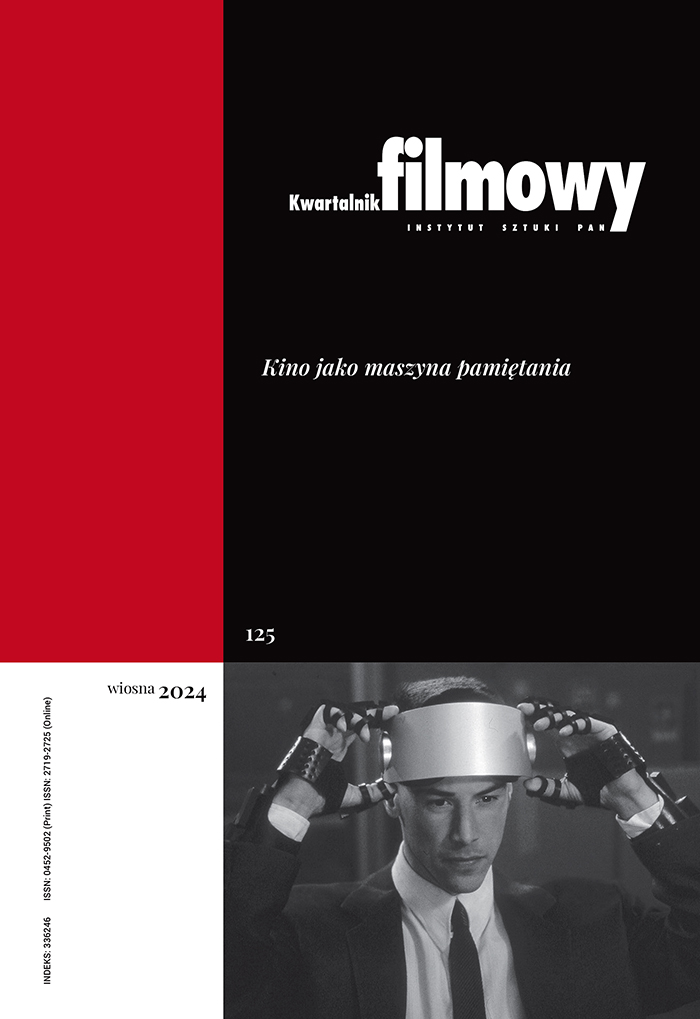Some Remarks on Space in Japanese Films
Abstract
The article presents the way space is used and arranged in Japanese films. The differences between Japanese and European art (for example in how objects are perceived, the role of perspective, the relation between the surface and the depth of the image, and the relationship between the center of an image and its borders) are reflected in how film images are constructed. The author points out certain key elements of image construction in Japanese cinematography. Kenji Mizoguchi, Yasujirö Ozu and Akira Kurosawa, tried to develop their own rules of building visual space, and who used perspective system used in traditional paintings.
Keywords:
Kenji Mizoguchi, Yasujiro Ozu, Akira Kurosawa, Japanese cinema, spaceReferences
Bordwell David, Mizoguchi and the Evolution of Film Language, w: Cinema and Language, red. S. Heath, P. Mellencamp, University Publications of America, Frederick 1983, s. 110.
Google Scholar
Bordwell David, Narration in the Fiction Film, University of Wisconsin Press, Madison 1985.
Google Scholar
Bordwell David, Ozu and the Poetics of Cinema,: Princeton University Press, Princeton 1988, s. 107, 145.
Google Scholar
Branigan Edward, The Space of Equinox Flower, „Screen” 1976, t. 17, nr 2, s. 95-97.
DOI: https://doi.org/10.1093/screen/17.2.74
Google Scholar
Burch Noël, To the Distant Observer: Form and Meaning in Japanese Cinema, University of California Press, Berkeley 1979, s. 160-161, 170-171, 228-229.
Google Scholar
Contreras Cynthia, Kobayashi’s Widescreen Aesthetic, w: Cinematic Landscapes: Observations on the Visual Arts and Cinema of China and Japan, red. L. C. Ehrlich, University of Texas Press, Austin 1994, s. 241-261.
Google Scholar
Davis Darrell William, Genroku Chūshingura and the Primacy of Perception, w: Cinematic Landscapes: Observations on the Visual Arts and Cinema of China and Japan, red. L. C. Ehrlich, University of Texas Press, Austin 1994, s. 187-217.
Google Scholar
Francastel Pierre, Twórczość malarska a społeczeństwo, tłum. J. Karbowska, A. Szczepańska, PIW, Warszawa 1973, s. 81.
Google Scholar
Hall Edward, Ukryty wymiar, tłum. T. Hołówka, Muza, Warszawa 2003, s. 71-72, 93.
Google Scholar
Kirihara Donald, Patterns of Time: Mizoguchi and the 1930s, University of Wisconsin Press, Madison 1992, s. 88-91.
Google Scholar
Okudaira Hideo, Emaki jako forma sztuki, tłum. W. Laskowska, w: Estetyka japońska, tom 2. Słowa i obrazy, red. K. Wilkoszewska, Universitas, Kraków 2005, s. 176.
Google Scholar
Ostrowska Elżbieta, Przestrzeń filmowa, Rabid, Kraków 2000, s. 43-68.
Google Scholar
Richie Donald, Ozu, University of California Press, Berkeley 1977, s. 170-174.
DOI: https://doi.org/10.1525/9780520353046
Google Scholar
Richie Donald, The Films of Akira Kurosawa, University of California Press, Berkeley 1996, s. 234.
DOI: https://doi.org/10.1525/9780520341784
Google Scholar
Russell Catherine, Too Close to Home: Naruse Mikio and Japanese Cinema of the 1950s, w: Global Cities: Cinema, Architecture, and Urbanism in a Digital Age, red. L. Krause, P. Petro, Rutgers University Press, New Brunswick 2003, s. 102.
Google Scholar
Thompson Kristin, David Bordwell, Space and Narrative in the Films of Ozu, „Screen” 1976, t. 17, nr 2, s. 41-73.
DOI: https://doi.org/10.1093/screen/17.2.41
Google Scholar
Thompson Kristin, Late Spring and Ozu’s Unreasonable Style, w: taż, Breaking the Glass Armor: Neoformalist Film Analysis, Princeton University Press, Princeton 1988, s. 332.
Google Scholar
Yoshimoto Mitsuhiro, Kurosawa: Film Studies and Japanese Cinema, Duke University Press, Durham 2000, s. 276.
DOI: https://doi.org/10.2307/j.ctv11smnqk
Google Scholar
Authors
Krzysztof Loskakwartalnik.filmowy@ispan.pl
Jagiellonian University Poland
Profesor UJ. Autor m.in. Encyklopedii filmu science fiction (2004), Tożsamości i mediów (2006). Współautor (z Andrzejem Pitrusem) książek: 100 filmów science fiction (2000) i David Cronenberg: rozpad ciała, rozpad gatunku (2003).
Statistics
Abstract views: 831PDF downloads: 137
License
Copyright (c) 2009 Krzysztof Loska

This work is licensed under a Creative Commons Attribution 4.0 International License.
The author grants the publisher a royalty-free non-exclusive licence (CC BY 4.0) to use the article in Kwartalnik Filmowy, retains full copyright, and agrees to identify the work as first having been published in Kwartalnik Filmowy should it be published or used again (download licence agreement). The journal is published under the CC BY 4.0 licence. By submitting an article, the author agrees to make it available under this licence.
In issues from 105-106 (2019) to 119 (2022) all articles were published under the CC BY-NC-ND 4.0 licence. During this period the authors granted a royalty-free non-exclusive licence (CC BY-ND 4.0) to use their article in „Kwartalnik Filmowy”, retained full copyright, and agreed to identify the work as first having been published in our journal should it be published or used again.
Most read articles by the same author(s)
- Krzysztof Loska, „Tropical Malady”, or on Humans, Animals and Spirits in Apichatpong Weerasethakul’s film , Kwartalnik Filmowy: No. 110 (2020): Beyond Human Being
- Krzysztof Loska, Histories of Polish Migrants in European Cinema , Kwartalnik Filmowy: No. 109 (2020): Architectural Space in Film
- Krzysztof Loska, Architecture and Japanese Colonialism – Cinematic Image of Cityscape in Occupied Seoul , Kwartalnik Filmowy: No. 109 (2020): Architectural Space in Film
- Krzysztof Loska, Journey to the New World. Cinematic Ethnographic Fiction in Post-Colonial Perspective , Kwartalnik Filmowy: No. 107 (2019): Journey, (E)migration, Pilgrimage
- Krzysztof Loska, Apichatpong Weerasethakul – About Politics and Spectres , Kwartalnik Filmowy: No. 105-106 (2019): Cinema and Political Transformation
- Krzysztof Loska, From the Point of View of Indigenous Peoples: Film as a Tool of Decolonization in Canada , Kwartalnik Filmowy: No. 116 (2021): Cinema and Social Identity
- Krzysztof Loska, Memory, Performance and Affects – Genocide in the Films by Joshua Oppenheimer , Kwartalnik Filmowy: No. 111 (2020): Senses and Affects
- Krzysztof Loska, Teinosuke Kinugasa, Neosensualism and the Avant-Garde , Kwartalnik Filmowy: No. 82 (2013): Experiment: Film and Audiovisual Arts
- Krzysztof Loska, Oscar Micheaux and the Beginnings of African-American Cinema , Kwartalnik Filmowy: No. 117 (2022): Unknown/Hidden Cinema
- Krzysztof Loska, Contemporary Horror in the Guise of Found Footage , Kwartalnik Filmowy: No. 104 (2018): Essay, Found Footage, Compilation Film











